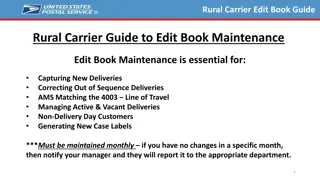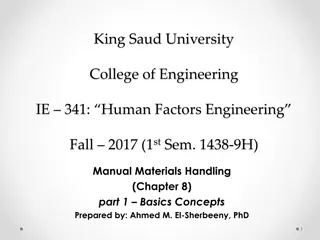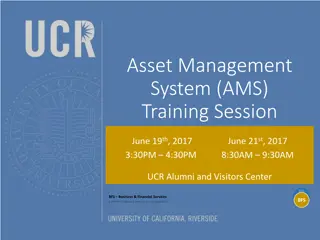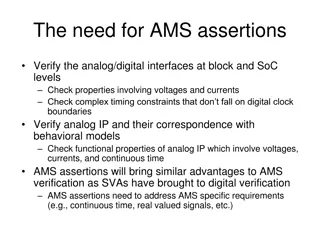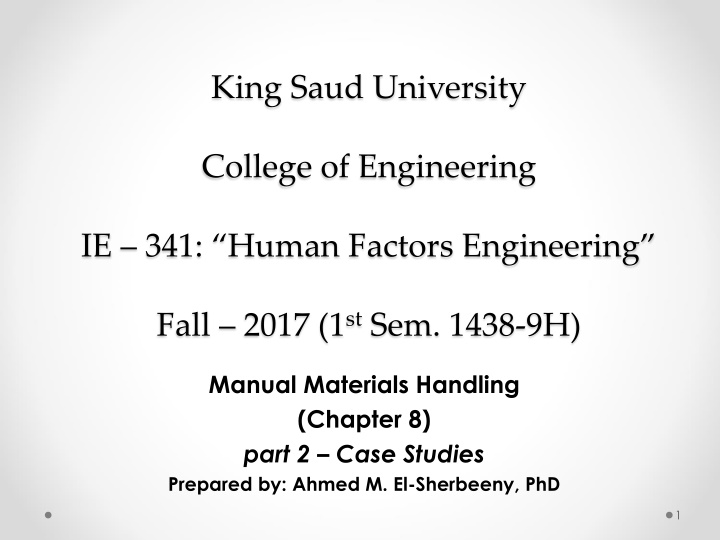
Analyzing the Effects of Frequency Factor on Recommended Weight Limit in Manual Materials Handling
Explore how the frequency factor impacts the recommended weight limit in manual materials handling tasks through a detailed case study. Understand the calculations involved and the implications for worker safety and ergonomics.
Download Presentation

Please find below an Image/Link to download the presentation.
The content on the website is provided AS IS for your information and personal use only. It may not be sold, licensed, or shared on other websites without obtaining consent from the author. If you encounter any issues during the download, it is possible that the publisher has removed the file from their server.
You are allowed to download the files provided on this website for personal or commercial use, subject to the condition that they are used lawfully. All files are the property of their respective owners.
The content on the website is provided AS IS for your information and personal use only. It may not be sold, licensed, or shared on other websites without obtaining consent from the author.
E N D
Presentation Transcript
King Saud University College of Engineering IE 341: Human Factors Engineering Fall 2017 (1st Sem. 1438-9H) Manual Materials Handling (Chapter 8) part 2 Case Studies Prepared by: Ahmed M. El-Sherbeeny, PhD 1
Lesson Overview Part 1: What is MMH? MMH Activities MMH Effect on Health NIOSH Lifting Equation Part 2: Case Studies o Case 1: Effect of Frequency Factor on RWL o Case 2: Effect of Horizontal Distance on RWL o Case 3: Effect of Vertical Distance on RWL 2
Case 1: Effect of Frequency Factor on RWL Problem Statement: Analyze the following work task. A worker lifts 10 kg boxes from the conveyor to the cart, ten times every minute for two-hours. 6 sec 3
Case 1: Effect of Frequency Factor on RWL Solution: First, calculate the recommended weight limit (RWL) for the task 1. Determine the weight of the load. Weight = 10 kg 2. Assess the six components of lifting task. H (Horizontal Distance) 20 cm V (Vertical Distance) 75 cm D (Lifting/ carrying Distance) 0 cm 90 A (Angle) F (Frequency) 6 sec C (Coupling/quality of grip) fair 4
Case 1: Effect of Frequency Factor on RWL 3. Select appropriate multiplier factors for each lifting component from the appropriate tables 1 H (Horizontal Distance) 20 cm HM 0.99* V (Vertical Distance) 75 cm VM D (Lifting/ carrying Distance) 1 0 cm DM 0.71 A (Angle) 90 AM 0.26 F (Frequency) 6 sec FM 1 C (Coupling/quality of grip) fair CM 5
Case 1: Effect of Frequency Factor on RWL 4. Determine the Recommended Weight Limit for the task: RWL RWL = 23 kg * 1 * .99 * 1 * 0.71 * 0.26 * 1 = 4 .2 kg 4 .2 kg Compare weight of the load against determined weight limit for the task: weight of load: L (10 kg) > RWL (4.2 kg) LI (lifting index) = L / RWL = 10 / 4.2 = 2.38 (i.e. 1<LI<3 lifting is risky) 5. 6. Conclusion: Task is Dangerous 6
Case 1: Effect of Frequency Factor on RWL Check results using NIOSH Lifting Eqn Calculator: 7
Case 1: Effect of Frequency Factor on RWL 7. Recommendations: Assess which component(s) contribute(s) most to the risk o the critical factor is FM it is required to reconsider the frequency of lifting and/or duration of task Shorten the frequency of lifting by: reducing the frequency of incoming boxes (i.e. increasing F) and/or assigning additional workers to task, and/or shortening the time of the task to 1 hour a. b. c. 8
Case 1: Effect of Frequency Factor on RWL 7. Recommendations (Cont.): 9
Case 1: Effect of Frequency Factor on RWL 8. Redesign the Task Assess the six components in the redesigned task Determine new RWL: RWL =23 kg * 1 1 * .99 .99 * 1 1 * 0.71 = 12.1 kg = 12.1 kg Compare weight of the box against determined weight limit for redesigned task: weight of load (10 kg): now < RWL (12.1 kg) Also, new LI = L / RWL = 10 / 12.1 = 0.83 (i.e. LI < 1) RWL =23 0.71 * 0.75 0.75 * 1 1 Conclusion: most workers can perform the task safely (why most?) 10
Case 1: Effect of Frequency Factor on RWL Check results using NIOSH Lifting Eqn Calculator: 11
Case 1: Effect of Frequency Factor on RWL NIOSH Lifting Eqn Calculator printable results: 12
(kg) 10 20 75 0 90 6 10 20 75 0 1 Fair 1.0 1.0 1.0 0.75 1.0 17.25 kg 23 1.0 12.25 kg 1.0 1.0 1.0 0.71 0.75 1.0 23 10 kg 0.58 17.25 kg 10 kg 0.82 13 12.25 kg
Case 2: Effect of Horizontal Dist. on RWL Problem Statement: Analyze the following work task. A worker lifts 15 kg boxes from the table to the shelf, five times an hour. Notice that there is a barrier between the worker and the box. 14
Case 3: Effect of Vertical Distance on RWL Problem Statement: Analyze the following work task. A worker lifts a 15 kg load of loosely-piled pieces of metal from the floor to the table, five times an hour. 15
References 1. Slides by: Dr. Khaled Al-Saleh; online at: http://faculty.ksu.edu.sa/alsaleh/default.aspx 2. Slides by: Dr. Mohammed Z. Ramadan; online at: http://faculty.ksu.edu.sa/mramadan/default.aspx 3. Revised NIOSH Equation for the Design and Evaluation of Manual Lifting Tasks. Thomas R. Walters et al. Ergonomics 36(7): 749-776,1993. 4. Applications Manual for the Revised NIOSH Lifting Equation. Thomas R. Walters, Vern Putz-Anderson, Arun Garg. US Department of Health and Human Services: Public Health Services. Cincinnati, OH, 1994. 5. OSHA Technical Manual. Section VII: Chapter 1: Back Disorders and Injuries. Online at: www.osha.gov/dts/osta/otm/otm_vii/otm_vii_1.html 16




